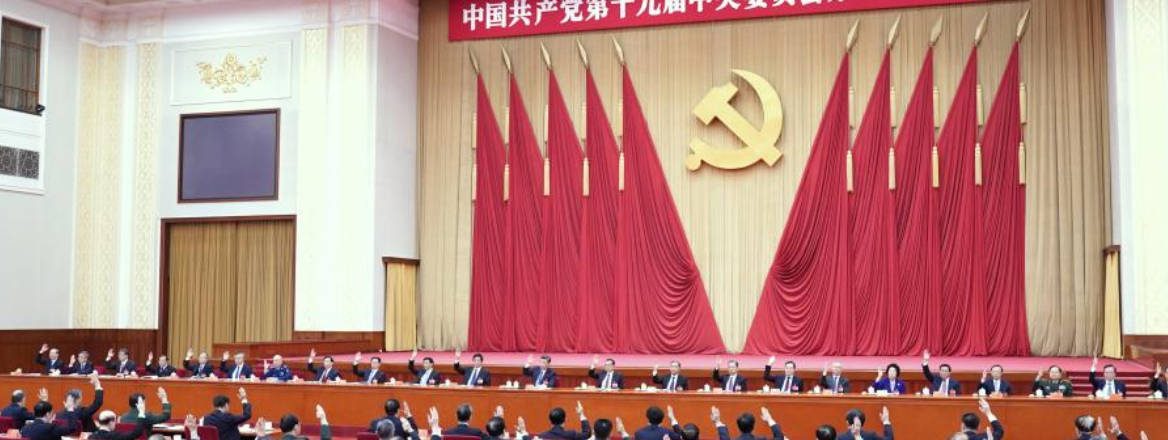Marching On: China’s Economic Plans and Visions After the Fifth Plenum
Despite a more difficult global environment and the coronavirus pandemic, China advances plans for a growth in power based on a greater role for the Party.
China recently issued the 14th Five-Year Plan (FYP), a blueprint for the next five years. It was coupled with the 2035 Vision Goals. The document weighs in at 20,000 characters, yet it is worth noting that they are not the final plan, but recommendations. We shall see refinements and detailed targets, where appropriate, when the National People's Congress (NPC) passes the FYP in March 2021. This maintains the fiction that the Party guides and the people decide. It is worth noting that this is not the first time that the Party has promulgated a 15-year vision: in 1995, it put out its aims for 2010.
Tough Challenges
Despite the usual upbeat language, the document acknowledges a tough external and domestic environment. As it highlights, ‘unbalanced and inadequate development of China remains prominent, the reform of key areas and key links remains a daunting task, and its innovation capacity does not adapt to the challenges of high-quality development’. While ‘seeking progress amidst stability’ remains the ‘main line’, a ‘new development concept’ is needed.
Unbalanced and Inadequate Development
Three elements stand out. The first is inequality. China no longer publicises its Gini co-efficient, but in 2014 one Chinese minister said in a private meeting that income gaps between regions, urban and rural areas, and individuals constituted one of the biggest threats to the Party remaining in power. Victory has been declared in the war on rural poverty, yet, as Premier Li Keqiang recently said, over 600 million people still live on a per capita income of less than 1,000 yuan (£115) a year. We can expect continued efforts to prevent any relapse into absolute poverty, as well as continued building of the social security net.
The second element is the countryside, agriculture and food security. Commentators tend to overlook its importance. Not the Chinese Communist Party (CCP), which claims that it will ‘insist on making the solution of the “three rural issues” a top priority for the Party’.
As Xi Jinping has stated, 60.6% of people in China may now live in the cities, but 39.4% do not. Many migrants in the cities perforce retain their rural registration and miss out on urban social security. This divide is a potential cause of instability. Moreover, 70% of children live outside prosperous cities, many in rural areas, and suffer from a lack of nutrition and education (the two are linked). Later training is ineffective if children have not learnt to learn.
Food security has always been a strategic priority of the CCP, and has become more important as relations with the US deteriorate and fears of possible moves to block imports rise. The modernisation of agriculture and the rural areas will receive much Party attention up to 2035.
The third element of inadequate development is the environment. This has long been one of Xi’s ‘three tough battles’. The costs to health and happiness (paid in protest and stability) will continue to rise if air, water and soil pollution is not successfully tackled. Expect ambitious targets in the final plan. Xi’s much remarked upon commitment to carbon neutrality by 2060 is too distant to be meaningful, but the acid test will be whether the centre can rein in current provincial plans to build coal-fired power stations. By population, no country risks suffering from climate change more than China, but balancing the environment against development and employment will be tricky.
Reform
The third plenum of 2013 announced reform of the economic and social system, to be completed by 2021. Yet reform remains high on the 14th FYP agenda. What is noticeable over the seven years since Xi undertook to reform is the balance between market and government roles. Compare 2013’s statement…
We must actively and in an orderly manner promote market-oriented reform in width and in depth, greatly reducing the government's role in the direct allocation of resources, and promote resources allocation according to market rules, market prices and market competition, so as to maximize the benefits and optimize the efficiency.
… with the one now:
Uphold and improve the basic socialist economic system, give full play to the decisive role of the market in the allocation of resources, give better play to the role of government, and promote a better combination of effective markets and proactive government.
Today’s language underlines the reality that a Leninist Party is not going to hand over to the market and its biggest players the levers of economic power, because that translates into political power. Whatever else lies behind the recent cancellation of the initial public offering of Jack Ma’s Ant Group, it is certainly a reminder of who is in charge. Reform is about tightening efficiency, further centralising of control and getting the market more efficiently to serve the Party’s will. Hence a lack of new thinking on state-owned enterprise reform, slow progress on land reform and slow upending of the hukou (registration) system, important for allowing free mobility of labour. On this last point, an April speech by President Xi, released just after the plenum, made clear that his new vision of urbanisation is to encourage migrants to steer clear of big cities – not just Beijing, Shanghai and Guangzhou, but provincial capitals and others.
Innovation
The recommendations place innovation at the top of the agenda as a ‘fundamental driving force’. Without innovation to ensure China a commanding position in the new industrial world, Xi’s ‘China Dream’ of a modern socialist superpower will evaporate.
The increased reluctance of the US and Europe to cooperate because of a perceived threat that China may use technologies for military purposes has added urgency. American restrictions on semi-conductors have been a wake-up call.
There has been a clear swing towards a role for the state in ensuring innovation. By contrast, the language in part of the 2013 reform document talked of the market driving science and technology research and innovation. Now the Party is to ‘unswervingly implement the new development concept of innovation’, and set up national projects and laboratories aimed at ‘frontier fields such as artificial intelligence, quantum information, integrated circuits, life and health, brain science, bio-breeding, space science and technology, and deep earth and deep sea…’.
This does not, of course, exclude the private sector. On the contrary, there will be measures to stimulate entrepreneurs’ innovation (such as tax incentives), but the state is to lead. The likely resources will ensure success in some areas – the Soviet Union produced some fine, usually military, technologies. Chinese firms have excelled in devising consumer-facing products. Nevertheless, questions remain about the dampening effects of not allowing a free flow of information and of over-rigid controls over education.
‘A New Development Concept and Pattern’
The 2035 Vision Goals (2035, because it is halfway between the two ‘centennial goals’ of 2021’s doubling of 2010’s per capita income, and 2049 when China is to become a ‘strong, democratic, civilized, harmonious, and modern socialist country’) require a ‘new development concept’, presumably a recognition that 2013’s reforms are past their sell-by date, partly because of a tough global environment. The target now is to double incomes again, as Xi appears to indicate in his ‘explanation’ of the plenum document: ‘It is entirely possible to double the total or per capita income’. This would indicate an annual growth rate of just under 5%, a target declared achievable by Huang Qifan, a former Chongqing mayor and economic heavyweight.
The new development concept emphasises the domestic market, ‘dual circulation’, increased consumption and better targeted investment. This is not China turning its back on the world, despite the reappearance of the Maoist phrase ‘自力更生’ (self-sufficiency). Autarky is not on the menu. Although, neither has a revamped version of the industrial policy ‘Made in China 2025’, which advocates for the expansion of Chinese technological capabilities, disappeared. Rather, it recognises that the outside world will not be as accommodating of China’s rise as in the past. Nevertheless, openness will remain a policy, bounded as in the past by negative lists to protect emerging industries or those central to national or economic security (widely defined). Sectors will open when China feels it is strong enough to dominate them. But the need for new technology, help with innovation, trade and investment require a relatively open economy.
Increased reliance on the domestic market makes sense, but it will not be easy, any more than increasing consumption has been easy in the past decade. The more vibrant private sector, despite the rhetoric, continues to lose out to the state-owned sector; the pressures on the people to save will be hard to disperse without a universal social security net and health system (nearly 300 million migrant labourers are largely excluded); the costs of China’s governance model are enormous, and this will not change, given the money needed for maintaining domestic control and surveillance, modernising the military, the Belt and Road Initiative, the Party and government employees, social security and health, education and much more. As for better targeted investment, that has been an aim for a good while and has proved difficult.
Conclusion
As ever, the language is necessarily upbeat. But the devil is in the detail, more of which will be revealed when the completed plan is passed by the NPC next year. In particular, it will be interesting to see what specific measures are brought forward for dealing with China’s biggest problems: debt, demographics, drought in the north, and rural/agricultural issues.
The views expressed in this Commentary are the author's, and do not represent those of RUSI or any other institution.
A clarification to a sentence on the 'Made in China 2025' policy was made on 13 November 2020.
WRITTEN BY
Charles Parton OBE
RUSI Senior Associate Fellow, International Security


